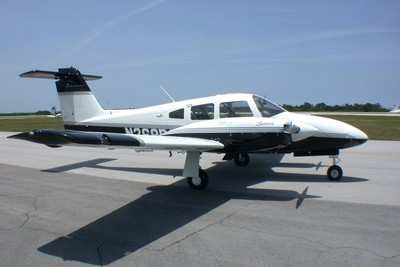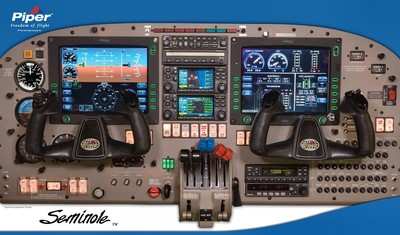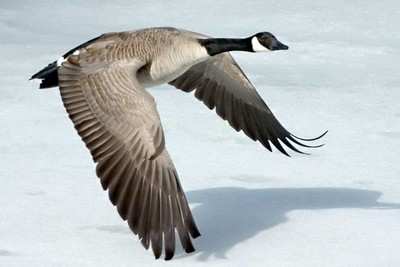Tragic Accident Killed CFI and Student
 An investigation into the night-time training accident that
killed two pilots in the fall of 2007 has revealed some troubling
data... with strong evidence that a goose collision contributed to
the outcome. Pilot Adam Ostapenko (20), of Duluth, Minn., and CFI
Annette Klosterman (22), of Seattle, were lost in this tragedy.
An investigation into the night-time training accident that
killed two pilots in the fall of 2007 has revealed some troubling
data... with strong evidence that a goose collision contributed to
the outcome. Pilot Adam Ostapenko (20), of Duluth, Minn., and CFI
Annette Klosterman (22), of Seattle, were lost in this tragedy.
The Probable Cause report states that, "The accident flight was
the third of a three-leg dual instructional night cross-country
flight. The airplane was established in normal cruise flight at
4,500 feet mean sea level (msl) when the airplane abruptly departed
controlled flight and impacted a bog. The bog was about 15 to 20
feet deep, with a thin layer of vegetation floating on the surface.
The airplane came to rest inverted, and damage to the airframe was
consistent with an inverted impact to the surface of the bog. Data
recovered from the airplane's flight display system indicated that
the airplane was in stable flight on a 320-degree magnetic heading,
at 4,500 feet msl, and approximately 160 knots true airspeed prior
to the accident, when it abruptly departed from controlled flight.
The airplane rolled approximately 20 degrees left wing down, yawed
to the left about 30 degrees, and simultaneously pitched nose-down
about 40 degrees. It then reversed and immediately entered a
descending, right roll for the duration of the flight. The airplane
impacted the bog within 30 seconds of the upset. The post accident
examination noted that the left half of the horizontal stabilator
was bent upward approximately 90 degrees, inconsistent with the
damage to the remainder of the airframe. This damage was consistent
with the initial left yaw and nose down pitch recorded during the
upset. In addition, a depression and tear were observed on the
upper wing skin near the left wing tip. Microscopic examination and
DNA testing of material on the inside surface of the wing skin was
identified as remains of a Canada goose. The natural history of
this species was consistent with the location, time, and date of
the accident."
The aircraft's problems seemed to have happened "abruptly."
According to the investigating report, the Seminole's (file photo,
below) Avidyne avionics "normally retain flight parameters in
non-volatile memory within the Primary Flight Display (PFD) and
Multifunction Display (MFD) units. Download of the data associated
with the MFD was not successful due to damage sustained in the
accident. Download of the PFD data was successful, however."
The PFD data indicated that the airplane was in stable flight on
a 320-degree magnetic heading, at 4,500 feet msl, and approximately
160 knots true airspeed prior to the accident. About 2211:46, the
airplane abruptly departed from controlled flight. It rolled
approximately 20 degrees left wing down, yawed to the left about 30
degrees, and simultaneously pitched nose down about 40 degrees. The
airplane then reversed and immediately entered a descending, right
roll for the duration of the flight. The recorded data ended about
2212:10.

A section of upper wing skin was taken from near the left wing
tip, at a point about mid-chord. The post accident examination
noted the presence of material on the inside surface of the wing
skin inconsistent with those used in the construction of an
aircraft. The wing skin section was along a tear in the skin,
adjacent to the spar. This portion of the airplane was submerged in
the bog after the accident until recovery of the airplane.
Microscopic examination and DNA testing by forensic
ornithologists identified the material on the wing skin section as
remains of a Canada goose. The ornithologists further noted that
the natural history of this species was consistent with the
location, time and date of the accident.

Of additional note, in the NTSB data, was an observation
concerning a portion of the wreckage, "The left half of the
stabilator was bent upward approximately 90 degrees at the tip,
which was inconsistent with the damage to the remainder of the
airframe. The inboard leading edge skin was torn from the spar. The
spar was deformed but appeared otherwise intact. The stabilator
section remained attached to the airframe by the spar, remaining
stabilator skin aft of the spar, and the anti-servo trim tab."
The NTSB reports added some interesting info to this report:
Analysis of bird strike data from 1990 through 2004 by the United
States Department of Agriculture, Wildlife Services, determined
that 74 percent of bird strikes occurred within 500 feet of the
ground, 19 percent between 500 feet agl and 3,500 feet agl, and 7
percent above 3,500 feet. Of the 26 percent of bird strikes that
occurred above 500 feet, about 7 times more strikes occurred at
night than during daylight hours. This was due to the fact that
about 61 percent of the reported strikes above 500 feet agl
occurred at night while only 18 percent of aircraft movements
occurred at night. In addition, a proportionally higher incidence
of strikes occurred between September and November, and between
April and May, as compared to the number of flight operations.
Further review of the data indicated that the probability of a
bird strike decreased by 32 percent for every 1,000-foot increase
in altitude. Outside of the airport environment, the altitude zone
from 500 feet agl to 3,500 feet agl was the most hazardous,
especially at night.

Canada geese were attributed to 668 strikes with civil aircraft
between 1990 and 2002. Of those strikes, 112 resulted in
substantial damage to the aircraft. The average mass of a Canada
goose is 9.2 lbs for a male and 7.8 lbs for a female, with a
maximum mass of 13.8 lbs. This species exhibits strong flocking
behavior.
The University of North Dakota provided additional pilot
training regarding bird strike hazards and mitigation. In addition,
they recommended to all of their pilots and flight instructors that
when possible higher cruise altitudes should be selected,
especially on night cross-country flights, in order to minimize the
probability of a bird strike.
The NTSB's Probable Cause determinations states that "An
in-flight collision with at least one Canada goose, and the
resulting damage to the left stabilator that caused the airplane to
become uncontrollable. Contributing to the accident was the night
lighting condition, which precluded any possibility of the flight
crew seeing the bird(s) prior to impact."
 ANN's Daily Aero-Linx (04.15.24)
ANN's Daily Aero-Linx (04.15.24) Classic Aero-TV: 'No Other Options' -- The Israeli Air Force's Danny Shapira
Classic Aero-TV: 'No Other Options' -- The Israeli Air Force's Danny Shapira Aero-News: Quote of the Day (04.15.24)
Aero-News: Quote of the Day (04.15.24) Airborne 04.16.24: RV Update, Affordable Flying Expo, Diamond Lil
Airborne 04.16.24: RV Update, Affordable Flying Expo, Diamond Lil ANN's Daily Aero-Term (04.16.24): Chart Supplement US
ANN's Daily Aero-Term (04.16.24): Chart Supplement US






